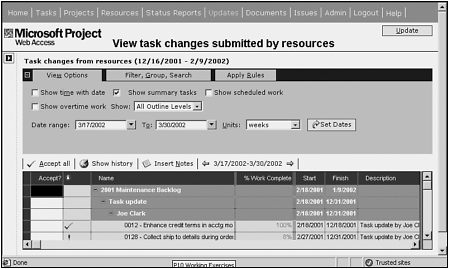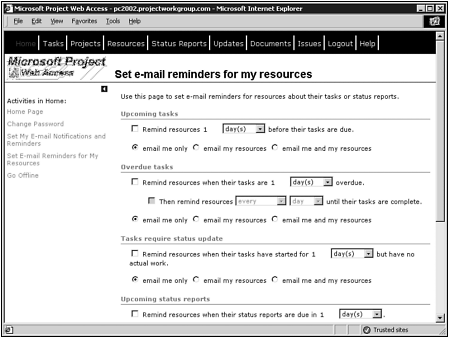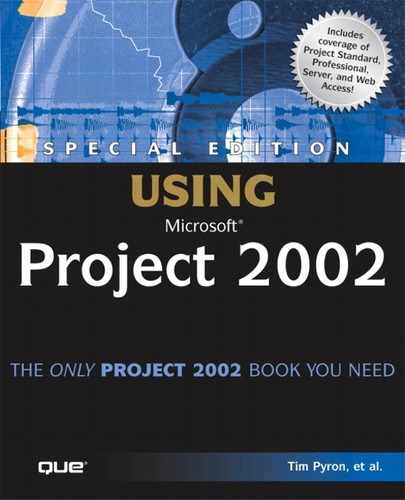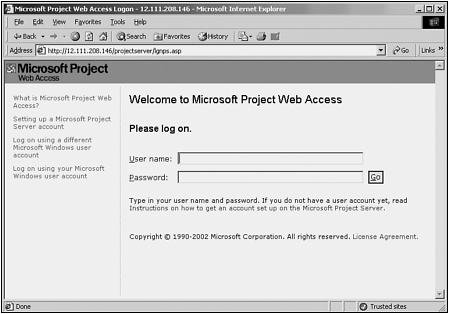Introduction to Microsoft Project Web Access
Microsoft Project 2002 expands on the Web-based workgroup features contained in Project 2000. With the added features in Project Web Access, a project manager can communicate task assignments and task updates with a project team quickly and easily. The project team, in turn, can send timesheets containing actual work values and project status reports back to the project manager, and project team members can access their task information in a variety of ways, including using a personal Gantt Chart view.
The Project Guide toolbar, shown in Figure 24.2, contains commands that help guide the user through the steps required to use Project Server. The Tasks and Resources commands include instructions to publish project information to the Web. The Track command leads to an extensive list of wizards to prepare for tracking progress and to set up tracking and status reports using the Web, and the Report command includes tools for both Project- and Project Server–based reporting.
Figure 24.2. The Project Guide toolbar leads to instructions and wizards that help with Project Server usage.
![]()
Updating a Project Plan to Project Server
You can either send a new project file to Microsoft Project Server or refresh a project file that already exists on the server. To do either of these, choose Collaborate, Publish, Project Plan. You’ll receive two messages—one indicating that the update is occurring and one when the update is complete. If you did not select an option on the Collaborate tab of the Options dialog box, you must remember to routinely perform this function.
Accessing Project Web Access
After you have set up a project plan, you can start using Microsoft Project Web Access. To access Project Web Access, follow these steps:
1. |
Start your browser and enter the Project Server URL in the address field. You are presented with the Microsoft Project Web Access login Web page (see Figure 24.3). Figure 24.3. The Microsoft Project Web Access login page enables you to log in to your home page.
|
2. |
Enter your name and password, and then click the Go button. |
When you log in to Project Web Access, you are presented with your home page (see Figure 24.4).
Figure 24.4. The Project Web Access home page provides an overview of updates, tasks, and issues assigned to you.

NOTE
Depending on the security setting of your Web browser, a security warning dialog box may appear for the ActiveX control being installed in the browser. High browser security settings can disable ActiveX and prevent Project Server from functioning. Check with your system administrator if you encounter security settings problems.
The Project Web Access home page has a new style in Project 2002. It is now more consistent with other Office Web applications and less cluttered than the Project Central version. (For example, drop-down menus have been eliminated to reduce clutter.)
The Project Web Access home page includes a set of tabs across the top for the main functional areas and an Actions pane on the left side to navigate within the pages in a particular area. The left-pointing arrow button at the top of the Actions pane allows you to hide the pane. When the Actions pane is hidden, a right-pointing arrow appears; you can use this button to toggle the pane back on.
The project manager’s home page that is shown in Figure 24.4 can include four major sections:
Updates— When resources update tasks, delegate tasks, make changes in their calendars, and so on, those updates are displayed in this section. This partially replaces the Messages section in Project Central.
Tasks— This section lists tasks that might be assigned to you; this feature also appeared in the Messages section in Project Central.
Status Reports— This is displayed only when status reports are pending.
Issues— If there are issues pending for your review, they are displayed, with indicators showing the current status: red when action is needed, green for resolved, and yellow for in-progress issues.
Updates in Project Web Access
In order to view the Updates section on the Project Web Access home page, you must have security permissions set to Manage Task Changes and Manage Calendar Changes; these are applied to the Project Manager group by default.
→ For further information about adding or modifying permissions, see Chapter 25, “An Overview of Microsoft Project Professional 2002,” p. 1007.
When updates are made to a project, a note appears on your Project Web Access home page, indicating how many changes have been made. Any updates to calendar information are displayed on a second line in the Updates section, along with the number of changes.
To access the Update Task Changes page, which is shown in Figure 24.5, click on either the Updates link or the Updates tab on the Project Web Access home page.
Figure 24.5. The Update Task Changes page allows a project manager to review changes before updating the associated project plan(s).

 | Depending on how often a team status meeting is held, the project manager might want to review team status on a weekly or biweekly basis. Most issues’ resolution and suggestions for corrective action to keep a project on time and on budget come out of these types of team meetings. Successfully knowing where the project stands at all times requires dedicated participation on the part of team members, who contribute progress reports, and project managers, who constantly monitor and assess performance during project execution. |
The Action pane on the Update Task Changes page provides four links to other related pages:
Update Task Changes Submitted by Resources— The options available for this page are described below.
Update Changes to Resources Calendars— This page contains options similar to those for the Updating task changes page.
Set Rules for Automatically Accepting Changes— The process for setting rules has not changed since Project 2000. Only the names of resources with permissions set to Send Updates and Delegate Tasks are available when creating rules. Rules take precedence; a rule can override the accept setting in the Updates grid if the rule is satisfied. Rules are not applied until you select the Run Rules Now button.
View History of Past Task Changes— This page holds all accepted and rejected updates for up to 60 days. The Filter, Group, and Search commands are available in this view.
The Update Task Changes page includes several tabs for reviewing the updates:
The View Options tab— This tab allows you to view scheduled work, overtime work, and summary tasks. You can also change the time period and the timescale for viewing updates, as shown in Figure 24.6.
Figure 24.6. The View Options tab allows the user to set the desired view as well as the date range and timescale units.

The Filter, Group, Search tab— Predefined filters and Autofilter are available, or you can create a custom filter. Grouping occurs by project, then by task change type, then by resource name (by default).
The Apply Rules tab— This tab applies the rules that have been set for automatically accepting updates into Microsoft Project on a per-project basis. This tab includes a link that takes you to the Manage Rules page.
The Update Task Changes page also includes the following options:
View History— This option takes you to the page where you can review previous updates.
Insert Notes— This option adds notes to the selected updates task.
Some general rules apply to the Update Task Changes page:
If a resource sends multiple updates on a single task, only the latest update displays.
If a resource delegates a task, a row is displayed in the update list. If the delegation is rejected, that update appears on a separate row and the Accept field is not editable.
Values that have changed since the last update are highlighted in red. Microsoft Project Server keeps track of which data has not yet been accepted into the project plan in order to ensure that updates are not overlooked.
If you reject an update for any reason, the team member that sent the update is notified.
If any updates cannot be completed, an alert is displayed.
Updates to the project manager can include a Comments field; these notes become read-only as soon as the assignment is updated to Microsoft Project. An additional note is appended to any existing task note, so the project manager does not end up with repeated task notes displays.
When an update transaction from Microsoft Project Server has successfully completed, the project file is automatically saved.
Email Notifications and Reminders
The Project Web Access home page includes the option to generate email notifications and reminders, by using two items in the Action pane:
Set My E-mail Notifications and Reminders.
Set E-mail Reminders for My Resources.
To see the actions that generate email notifications, click the Set My E-mail Notifications and Reminders link, and the page shown in Figure 24.7 appears.
Figure 24.7. The Set My E-mail Notifications and Reminders page allows the user to determine when notifications will be generated.

The personal reminder options are shown at the bottom of the Set My E-mail Notifications and Reminders page. These options allow each user to determine which reminders about their own tasks, status reports, and issues will be received. These reminders are different from the action-driven email notifications in that they are about existing events and can be recurring.
Project generates reminders after making a daily scan of the Server database, as scheduled by the administrator; this process sends up to three emails per user per day.
A manager can also set reminders for resources that have assignments in the manager’s projects by using the Set E-mail Reminders for My Resources link. Reminders can be set for upcoming tasks, overdue tasks, tasks requiring status update, and upcoming and overdue status reports, as shown in Figure 24.8.
Figure 24.8. The Set E-mail Reminders for My Resources page allows a manager to determine when reminders to assigned resources will be generated.

The Subscribe to Receive Email Notifications When Items Change link on the Home page allows the user to control the amount of email received and takes the user directly to the Set My E-mail Notifications and Reminders page.
Other useful links on the Project Web Access home page allow users to integrate Microsoft Project Web Access and Microsoft Outlook, either through a shortcut or a Digital Dashboard.

